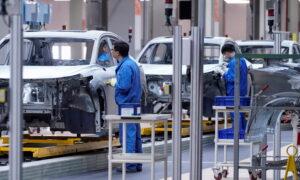Environment Minister Steven Guilbeault has announced Ottawa’s plan to make all new vehicles sold in Canada zero-emission electric vehicles (EVs) by 2035.
“The electric vehicle availability standard that drives Canada towards all new light-duty vehicle sales in Canada to be electric or plug-in hybrid by 2035,” Mr. Guilbeault said during a press conference on Dec. 19.
“This includes the interim goals along the way, beginning with 20 percent of all new vehicle sales being EVs by 2026.”
The plan will require Canadian vehicle manufacturers to ensure at least one-fifth of the vehicles they sell in 2026 are fully electric or plug-in hybrids. That number will rise to three-fifths by 2030 and then to 100 percent by 2035.
Mr. Guilbeault described the government’s strategy on EVs as “skating to where the puck is going,” noting that one in eight new vehicles sold across Canada was electric in the last quarter of 2023, compared to one in three at the end of 2020.
“There’s no mistaking it, we are at a tipping point. And the automakers are themselves all going electric today,” he added.
The environment minister said the Electric Vehicle Availability Standard would tackle one of the “main barriers” to people buying EVs; the limited availability and long wait time. “We will do this by ensuring more electric cars come to the Canadian market instead of the U.S. or other markets that have similar targets. It ensures Canadians have access to our fair share of the global supply of these vehicles,” Mr. Guilbeault said.
The electric-vehicle sales mandate regulations, to be published later this week, will include a system where every automaker will have to show that a minimum percentage of vehicles they offer for sale are fully electric or longer-range plug-in hybrids.

Automakers will be issued credits by the Canadian Environmental Protection Act for the EVs they sell, with an electric model being worth one credit and plug-in hybrids being worth a partial or full credit depending on how far they go on a single charge. Manufacturers that sell more EVs than needed to meet each year’s target will be able to bank those credits to meet targets in future years or sell them to companies that did not sell enough.
Auto manufacturers can also cover up to 10 percent of the credits they need each year by investing in public fast-charging stations, which Mr. Guilbeault said would help ease the “range anxiety” felt by some EV owners who don’t live or work close to charging stations. Automakers will be able to begin earning some credits toward their 2026 and 2027 targets over the next two years.
Alberta Premier Danielle Smith, who has been critical of the federal government’s climate change policies, said the new mandate goes against the interest of Canadians.
EVs in Canada
Interest in EVs declined in Canada in 2023, according to a recent report by AutoTrader, which found only 56 percent of non-EV owners expressing an intent to purchase them, down from 68 percent in 2022. The report attributed this to fluctuating gas prices, as higher prices tend to increase EV interest.The federal government has made significant investments in electric vehicle battery factories in the past year, including $13.2 billion in subsidies to Volkswagen’s battery cell plant in St. Thomas, Ont., and partnering with the Ontario government to give a combined $15 billion in subsidies to Stellantis-LG Energy Solution to build an EV battery plant in Windsor, Ont.
In Quebec, the federal government and the province are also considering giving Northvolt $4.6 billion to build an EV battery plant. Finance Minister Chrystia Freeland previously said the new factories would create “thousands of jobs” in the auto sector, which would cement Canada’s place as a “leader in the global electric vehicle supply chain.”







